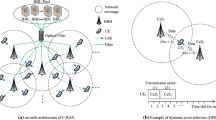Abstract
Mobile cloud computing is a promising technique that shifts the data and computing service modules from individual devices to a cloud architecture. When the service is executed in the cloud clone, the data transfer between the mobile terminal (MT) and its clone requires low end-to-end communication delay. However, it is very difficult to predict the speed and direction of an MT in a timely fashion. Thus, the service handoff between different access points (APs) may cause long handoff delay. To address this issue, we propose a proactive service handoff mechanism using the Delaunay triangulation (called as DTSHM mechanism). The DTSHM constructs all the APs into a Delaunay triangulation topology. For an MT located in a Delaunay triangle, its next handoff procedure only happens between the three vertices (i.e. APs) of this triangle no matter how it moves. It is because the circumcircle of each Delaunay triangle does not contain any other APs in its interior. Thus, a Delaunay triangle is characterized as the master-standby service model which is composed of a master AP and two standby APs. In the DTSHM, The cloud clone in advance authenticates and buffers the required data packets of an MT in the standby APs. Thus, the clone can quickly handoff the cloud service from the source AP to the target AP when the handoff process is triggered. The simulation results and the performance analysis show that the DTSHM works very well.




Similar content being viewed by others
References
MarketWatch. (2014). 2014–2018 Forecasts in New Research Report. http://www.marketwatch.com
Sanaei, Z., Abolfazli, S., & Gani, A. (2013). Heterogeneity in mobile cloud computing: Taxonomy and open challenges. IEEE Communications Surveys & Tutorials, 16(1), 1–24.
Dinh, H. T., Lee, C., Niyato, D., & Wang, P. (2013). A survey of mobile cloud computing: Architecture, applications, and approaches. Wireless Communications and Mobile Computing, 13(18), 1587–1611.
Abolfazli, S., Sanaei, Z., & Gani, A. (2012). Mobile cloud computing: A review on smartphone augmentation approaches. In Proceedings of the CISCO.
Cuervo, E., Balasubramanian, A., Cho, D. K., Wolman, A., Saroiu, S., Chandra, R., et al. (2010). MAUI: Making smartphones last longer with code offload. In Proceedings of the ACM MobiSys (pp. 49–62).
Chun, B. G., Ihm, S., Maniatis, P., Naik, M., & Patti, A. (2011). CloneCloud: Elastic execution between mobile device and cloud. In Proceedings of the ACM EuroSys (pp. 301–314).
Satyanarayanan, M., Bahl, P., Caceres, R., & Davies, N. (2009). The case for VM-based cloudlets in mobile computing. IEEE Pervasive Computing, 8(4), 14–23.
Kosta, S., Perta, V. C., Stefa, J., Hui, P., & Mei, A (2013). Clone2clone (c2c): Peer-to-peer networking of smartphones on the cloud. In Proceedings of the USENIX HotCloud.
Makaya, C., & Pierre, S. (2008). An analytical framework for performance evaluation of IPv6-based mobility managenment protocols. IEEE Transactions on Wireless Communications, 7(3), 972–983.
Koodli, R. (2003). Fast handovers for mobile IPv6, Internet Draft, IETF.
Chen, Y. S., Chuang, M. C., & Chen, C. K. (2008). DeuceScan: Deuce-based fast handoff scheme in IEEE 802.11 wireless networks. IEEE Transactions on Vehicular Technology, 57(2), 1126–1141.
Han, Y. H., Choi, J., & Hwang, S. H. (2006). Reactive handover optimization in IPv6-based mobile networks. IEEE Journal on Selected Areas in Communications, 24(9), 1758–1772.
Taleb, T., Letaief, K. (2010). A cooperative diversity based handoff management scheme. IEEE Transactions on Wireless Communications, 9(4), 1462–1471.
Chen, Y. H., Chang, C. J. (2007). A fast handoff protocol for cellular IEEE 802.11e WLAN systems. IEEE Communications Letters, 11(2), 140–142.
Chen, Y. S., Hsiao, W. H., & Chiu, K. L. (2009). A cross-layer partner-based fast handoff mechanism for IEEE 802.11 wireless networks. International Journal of Communication Systems, 22(12), 1515–1541.
Zhang, L., Seta, N., Miyajima, H., & Hayashi, H. (2007). Fast authentication based on heuristic movement prediction for seamless handover in wireless access environment. In Proceedings of the IEEE WCNC (pp. 2889–2893).
Seshan, S., Balakrishnan, H., & Katz, R. H. (1997). Handoffs in cellular wireless networks: The daedalus implementation and experience. Journal of Wireless Personal Communications, 4(2), 141–162.
Shim, E., Wei, H. Y., Chang, Y., & Gitlin, R. D. (2002). Low latency handoff for wireless IP QoS with neighborcasting. In Proceedings of the ICC (pp. 3245–3249).
Gwon, Y., Fu, G., & Jain, R. (2003). Fast handoffs in wireless LAN networks using mobile initiated tunneling handoff protocol for IPv4 (MITHv4). In Proceedings of the WCNC (pp. 1248–1253).
Klein, A., Mannweiler, C., Schneider, J., & Schotten, H. D. (2010). Access schemes for mobile cloud computing. In Proceedings of the IEEE MDM (pp. 387–392).
Li, H., & Xie, J. (2012). A low-cost channel scheduling design for multi-hop handoff delay reduction in internet-based wireless mesh networks. In Proceedings of the IEEE infocom (pp. 307–315).
Lin, Y., Shao, L., Zhu, Z., Wang, Q., & Sabhikhi, R. K. (2010). Wireless network cloud: Architecture and system requirements. IBM Journal of Research and Development, 54(1), 1–12.
Garey, M. R., & Johnson, D. S. (1979). Computers and intractability: A guide to the theory of NP-completeness. San Francisco: W. H. Freeman.
De Berg, M. (1999). Computational geometry algorithms and applications. Berlin: Springer.
Network Simulator 2—NS2. http://www-mash.cs.berkeley.edu/ns/
Acknowledgments
The original version of this work has been published in WPMC 2013. This work was supported by the National Nature Science Foundation of China under Grants 61173017, 61100207 and the Opening Project of Key Lab of Information Network Security of Ministry of Public Security under Grant C14613.
Author information
Authors and Affiliations
Corresponding author
Rights and permissions
About this article
Cite this article
Yang, Z., Liu, X., Hu, Z. et al. Seamless Service Handoff Based on Delaunay Triangulation for Mobile Cloud Computing. Wireless Pers Commun 93, 795–809 (2017). https://doi.org/10.1007/s11277-014-2229-6
Published:
Issue Date:
DOI: https://doi.org/10.1007/s11277-014-2229-6




